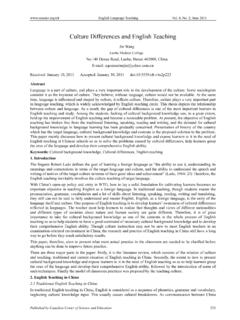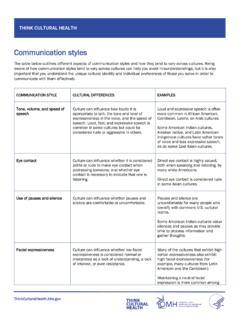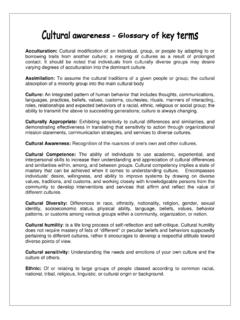Transcription of Cultural Sensitivity to Help While Serving Native American …
1 Office of Rural Health Webinar, June 27th, 2012 Cultural Awareness to help While Serving Native Veterans Presenter: Buck Richardson, Jr MVPC, VA Rocky Mtn Network Moderator: Jay H. Shore, MD, MPH Native Domain Lead, Veterans Rural Health Resource Center-Western Region Outline of Power Point 3 Brief Overview of Office of Rural Health s Native Domain Native Veterans and their communities Cultural Aspects of work with Native Peoples Cultural Aspects of work with Native Veterans Collaboration with Traditional Medicine 4 Native Veterans and their communities Diversity of Native Communities 5 4,222,760 American Indians and Alaska natives and 909,770 Native Hawaiian and Pacific Islanders in the and its territories(US Census 2007)
2 560+ federally recognized American Indian and Alaska Native tribes and villages 245 non-Federally recognized tribes many who are recognized by their States and are seeking Federal recognition 28% of American Indian and Alaska natives 5 years old or older speak a language other than English at home Creative Commons Photo: Permalink: Repository: National Museum of the American Indian. US Census Map 6 Native American Veterans 7 Native Americans Share a Proud Warrior Tradition Native Americans enroll in the armed services at a higher rate than any other ethnic population Today over 346,623 veterans identify themselves as AI/AN (US Census 2010)
3 38% rural/highly rural, proportionately more than other racial/ethnic groups Challenges for Native American Veterans 8 Disproportionately impacted by military services Higher Rates of PTSD due to higher trauma exposure Common medical co-occurring illnesses Rural Location Availability of specialized health care services is scarce Difficult to recruit providers Cultural access barriers Acquiring culturally competent providers within a Native community is an even greater challenge 9 Cultural aspects of work with Native Peoples Traditional Native American Values 10 Dominant Society Values Native - American Traditional Values Self is the
4 Priority = Take care of #1 Tribe and extended family before self first, Prepare for tomorrow Today (is a good day) Time (linear; use every minute) Time a right time, non-linear a right place, Youth (value rich, young, beautiful) Age (knowledge, wisdom) Compete to get ahead Cooperate Be aggressive Be patient Speak up Listen (and you ll learn) Take and save Give and share Conquer nature Live in harmony (with all things) Skepticism and logical thinking valued Great mystery the intuitive honored ** Wounded Spirits, Ailing Hearts. PTSD and the Legacy of War Among American Indian and Alaska Native Veterans. [Independent Study] Produced with the National Center for PTSD by the Department of Veterans Affairs VA Employee Education System.
5 Release Date: October 2000. Traditional Native American Values Dominant Society Values Native - American Traditional Values Self is more important than group Humility Religion is a part of life A spiritual life (religion not separate ) Be a critical thinker Don t criticize your people Live with your mind Live with your hands manual activity is sacred Orient yourself to a house and job Orient yourself to the land You re in America: speak English! Cherish your own language and speak it when possible Discipline your own children Children are a gift of the Great Spirit to be shared with others Have a rule for every contingency Few rules are best, loose written and flexible Have instruments judge for you Judge things for yourself 11 ** Wounded Spirits, Ailing Hearts.
6 PTSD and the Legacy of War Among American Indian and Alaska Native Veterans. [Independent Study] Produced with the National Center for PTSD by the Department of Veterans Affairs VA Employee Education System . Release Date: October 2000. Understanding Native Culture 12 Diversity of culture between and within communities Individual community members hold multiple Cultural identities Elders and Veterans accorded important status Creative Commons Photo: Permalink: +084 Repository: National Museum of the American Indian. Understanding Native Culture 13 Family Relearned Family often includes grandparents, uncles/aunts, cousins and many others Extended families in one household, grandparents often raise grandchildren Sense of responsibility for providing for family ( emotional , physical, $) Understanding Native Culture 14 Community Revisited Community issues often have great effects on the individual Community problems are everybody s problems Community is family Strength and support can be found in family and community networks for individuals in distress Creative Commons Photo: Permalink: Repository.
7 Department of Interior. Communication Norms 15 Speech Pattern Adapt your tone of voice, volume, and speed of speech patterns to fit patients communication style In many case speech may be: Slower Silence more acceptable Learn not to interrupt Let a story be finished Defer to Elders Respect narrative style of communication Communication Norms 16 Eye contact varies in many cultures For many Native cultures, direct eye contact may be considered rude and disrespectful Be familiar with community norms around eye contact Be careful not to misinterpret lack of eye contact as a clinical sign ( , depression) Importance of Body Language and Non-verbal Cues 17 Personal Space Wide variation in comfort levels with interpersonal proximity Importance of body language and non-verbal communication Dress Dress (esp.)
8 In rural communities) is often casual. Over-dressing may create an the impression of aloofness 18 Cultural aspects of work with Native Veterans What is Culturally Competent Care? 19 The culturally-competent caregiver acknowledges that societal differences impact patients behavior, beliefs, and values and the caregiver works to incorporate these differences into individual patient s healthcare assessment, diagnosis, and treatment. Creative Commons Photo: Permalink: Repository: National Museum of the American Indian. Working with Native Cultures 20 Tips on Incorporating Culturally-Competent Care with Native Populations Become familiar with local communication styles.
9 Modify yours as appropriate (slow down, listen, don t interrupt) Ask patients about their tribe, their family history Ask patients about their ideas of healthcare (personal practices, expectations) Rapport building may take longer When establishing rapport, use issues that matter to the patient Understand the possibility of system transference System Transference 21 Transference in mental health is when experience with past relationships influences impressions of current relationships System Transference is when past experience with a system(s) (eg. VA, Federal Government) influences current feelings and reactions to a system(s)
10 If past history is positive then more trust and optimism in interfacing with current system If past history is negative then more distrust and pessimism in interfacing with system System Transference Historical Context 22 Community History of genocide, warfare and disease Broken Treaties Reservation Policy Boarding Schools Individual Military experience VA experience Institutionalized prejudice Managing System Transference 23 Balanced and open acknowledgement of past issues and problems without making excuses, rationalization or blaming Willingness to listen Willingness to help address, facilitate and navigate current system issues Be realistic, don t overpromise, follow through and communicate back to Veteran Your behavior trumps your words 24 Collaboration with Traditional Medicine Dancing to Restore an Eclipsed Moon 25 Creative Commons Photo: Permalink: Repository: Smithsonian Institution Libraries.







